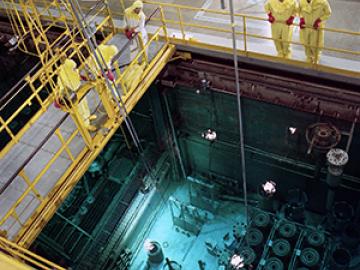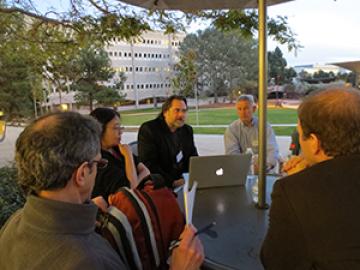Filter News
Area of Research
- (-) Neutron Science (6)
- (-) Nuclear Science and Technology (5)
- Advanced Manufacturing (3)
- Biological Systems (3)
- Biology and Soft Matter (3)
- Building Technologies (3)
- Chemical and Engineering Materials (2)
- Chemistry and Physics at Interfaces (5)
- Clean Energy (19)
- Climate and Environmental Systems (4)
- Computational Biology (1)
- Computational Chemistry (4)
- Computational Engineering (1)
- Computer Science (1)
- Earth Sciences (1)
- Energy Frontier Research Centers (6)
- Fuel Cycle Science and Technology (1)
- Functional Materials for Energy (8)
- Geographic Information Science and Technology (1)
- Materials (31)
- Materials for Computing (7)
- Materials Synthesis from Atoms to Systems (8)
- Materials Under Extremes (5)
- Neutron Data Analysis and Visualization (2)
- Nuclear Systems Technology (1)
- Quantum Condensed Matter (2)
- Renewable Energy (1)
- Sensors and Controls (1)
- Supercomputing (15)
- Transportation Systems (3)
News Topics
Media Contacts

For more than 50 years, scientists have debated what turns particular oxide insulators, in which electrons barely move, into metals, in which electrons flow freely.

When Orlando Rios first started analyzing samples of carbon fibers made from a woody plant polymer known as lignin, he noticed something unusual. The material’s microstructure -- a mixture of perfectly spherical nanoscale crystallites distributed within a fibrous matrix -- looked almost too good to be true.

Blowing bubbles may be fun for kids, but for engineers, bubbles can disrupt fluid flow and damage metal.

The High Flux Isotope Reactor, or HFIR, now in its 48th year of providing neutrons for research and isotope production at the Department of Energy’s Oak Ridge National Laboratory, has been designated a Nuclear Historic Landmark by the American Nuclear Society (ANS).

The Department of Energy’s Oak Ridge National Laboratory concluded a series of workshops this month that engaged scientists from around the country to identify grand scientific challenges and how they might be addressed through application of neutron science.

Neutron scattering research at the Department of Energy’s Oak Ridge National Laboratory has revealed clear structural differences in the normal and pathological forms of a protein involved in Huntington’s disease.

The Spallation Neutron Source at the Department of Energy’s Oak Ridge National Laboratory broke records for sustained beam power level as well as for integrated energy and target lifetime in the month of June.

A team representing Westinghouse Electric Company and the Consortium for Advanced Simulation of Light Water Reactors (CASL), a Department of Energy (DOE) Innovation Hub led by Oak Ridge National Laboratory (ORNL), has received an International Data Corporation HPC Innovation Excellence Award for applied simulation on Titan, the nation’s most powerful supercomputer, which is managed by the Oak Ridge Leadership Computing Facility at ORNL. s

The American Conference on Neutron Scattering returned to Knoxville this week, 12 years after its inaugural meeting there in 2002.

Oak Ridge National Laboratory researcher John Wagner has been named a 2013 recipient of the Department of Energy’s Ernest Orlando Lawrence Award for his work in advancing computer, information and knowledge sciences.




